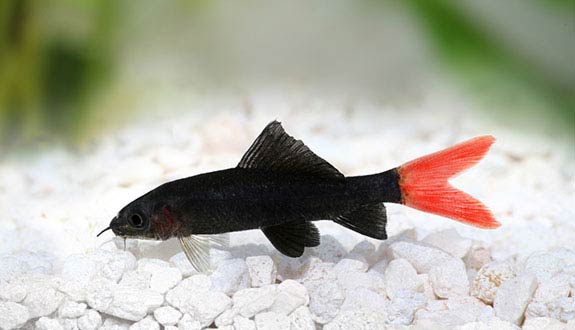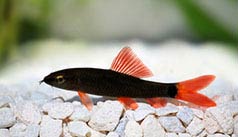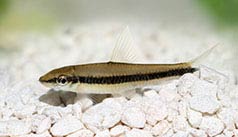

Alternative species (click on the thumbnail to see the card)
Names
Scientific name
Epalzeorhynchos bicolor
Labeo bicolor
Common name
Redtail shark
Red-tailed labeo
Origin

Origin: Thailand
Biotope: Asian
Dimorphism

The caudal male is bright red, less colored in the female. The female is bigger and more plump
Group

Cyprinidae
Volume

250 L / 55 imp gal / 66 US gal alone
800 L / 176 imp gal / 211 US gal in group
Parameters

T°: 22 to 28°C or 72 to 82°F
pH: 6.5 to 7
Hardness: 5 to 15°dGH
Difficulty

Average
Size

10 to 15cm (4 to 5.9")
Longevity

4 to 15 years
Living zone

Middle and depth
Individuals

1 or 5/6
Food
How to feed the Redtail shark?
Food
How to feed the Redtail shark?
Omnivorous: all forms of food are accepted with plant supplements (eg zucchini, cucumber, shucked peas, spinach).
Behavior
What kind of behavior does the Redtail shark have?
Behavior
What kind of behavior does the Redtail shark have?
When young, it is quite gregarious. However, as it ages, it becomes aggressive, very territorial and it lives alone. Cohabitation with its congeners is possible only in very large volumes (800 L or 210 gal) and with 6 individuals (to establish a stable hierarchy) introduced together from their youngest ages.
Very dynamic and active, it likes big spaces. Its bad temper is ultimately a sense of the very developed territory. If the aquarist is interested, understands and adapts to the territorial rules of the Red-tailed Labeo, it becomes again a calm and serene fish.
Cohabitation
Who can live with the Redtail shark?
Cohabitation
Who can live with the Redtail shark?
Even if the Red-tailed Labeo is often sold to go in a community aquarium, a specific aquarium is recommended. Indeed, if it is the only representative of its species, it will not hesitate to attack all fish in the aquarium and all territorial fish. It is slightly more flexible with non-territorial species. Calm and shy species are therefore to be banned absolutely.
It seems that it leaves in peace the groupers (Syncrossus, Chromobotia, Yasuhikotakia and Botia) while its aggressiveness will focus on its congeners (Epalzeorhynchos) and on fish that resemble it like Crossocheilus, Garra, Balantiocheilus and Gyrinocheilus.
In a large volume (500 L or 130 gal), it can possibly cohabit with large Cichlids with a strong temper, or with some very lively species such as Puntigrus tetrazona (Sumatra barbs), Etroplus or Danios.
At the end, all the population of the aquarium must be thought around the Red-tailed Labeo alone!
Breeding
How to breed the Redtail shark?
Breeding
How to breed the Redtail shark?
The breeding of the Red-tailed Labeo is only very rarely successful. Place in a spawning tank (200 L or 50 gal) consisting of many hiding places and plant clump, 1 male and 1 female. Temperature 24/27°C or 75/80°F and pH at 6.5/7. Powerful filtration will generate a large current. The lighting will be sieved. Spawning takes place within 24 hours. A laying may include up to 1000 eggs. The incubation lasts 36 hours. From the age of one month, add vegetable supplements to their food.
Fry food: infusoria, then nauplies of artemia and cyclops.
Its aquarium
Which aquarium for the Redtail shark?
Its aquarium
Which aquarium for the Redtail shark?
In general, plan a luxurious aquarium on the outskirts with peat bog roots. For the substrate, opt for a fine sand. Also sift the light with floating plants.
For a more specific aquarium approaching its natural habitat, the tank must look like a flowing river. So you can add rocks of varying sizes and gravel. Also place driftwood branches and plants like Microsorum, Bolbitis or Anubias. Finally, generate a moderate current.
Good To know
Find all additional information!
Good To know
Find all additional information!
Although robust, its maintenance is rather reserved for aquarists experience due to its very particular character.
In addition, Red-tailed Labeo is sold as a «algae eater», while it is still less effective in this area than Crossocheilus. Do not buy it for this reason or you will have a big problem of cohabitation.
It can become gray or green because of stress.
There is an Albino variety of Epalzeo that would be less aggressive.
Yours photos!
Comments
Sort by:
Please login to post comments



